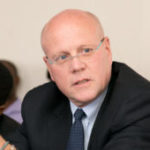As each of us considers the long-term impacts of COVID-19, we must confront the reality; the virus has caused a major disruption in global HIV and AIDS efforts. The direct and indirect effect on vulnerable and marginalized populations around the world is sure to be staggering.
A recent report by the Gates Foundation calls attention to the decades of global health progress lost in only a few short months warning, “we’ve been set back about 25 years in about 25 weeks.” A study in The Lancet notes that even short interruptions in HIV prevention and treatment services, and particularly antiretroviral therapy programs, could lead to substantial increases in mortality, particularly in countries where HIV prevalence is high.
Kenya is experiencing a decrease in women accessing antenatal care, a crucial entry point for HIV services, which allows pregnant women and girls newly diagnosed with HIV to rapidly access treatments that support their own health and prevent transmission to their baby. On our end, EGPAF programs are also seeing significant reductions in pediatric testing. If mothers don’t receive critical resources and children aren’t tested, we can expect to see unacceptable increases in new pediatric infections.
It is becoming increasingly clear that HIV positive pregnant women and children are particularly vulnerable in our current environment.
And yet amidst these sobering forecasts, we must push through the uncertainty and find our calls to action. The disruptions to health services due to COVID-19 will no doubt make their mark, but with the proper agility and dedicated investment, we can and must work to mitigate the lasting damage.
In striving to assess the future impacts of COVID-19, the global health community is limited by so much that is still unknown. Yet it is clear that in many regions, COVID-19 is preventing people living with HIV from accessing the treatment and services they need to stay healthy, and those at risk of infection face new obstacles to prevention and testing.
Experts also anticipate the ramifications will certainly have an outsized effect on children and young people. Unfortunately, we still don’t have adequate information to understand exactly how COVID-19 uniquely affects children, or what risks it poses for pregnant women and their babies. Worse still, as the scientific community fast tracks a vaccine, trials for children have not been prioritized meaning pediatric vaccine availability will lag far behind adults. A vaccine that is inaccessible to children—a quarter of the global population—will reduce the impact for us all. Just as our founder Elizabeth Glaser did over three decades ago, we will continue to push for this indispensable data and advocate for the crucial inclusion of pregnant women and children in COVID-19 research and trials.
A vaccine that is inaccessible to children—a quarter of the global population—will reduce the impact for us all.
Fighting two pandemics at once is a daunting task. Sadly, the global response to HIV in children was flagging long before the emergence of the coronavirus, and now COVID-19 has exacerbated the vast inequities that already existed. If there is a constant theme around children and HIV, it is that they are continuously viewed as a low priority. Children do not have political influence or have a voice commensurate with their health needs.
We cannot wait until the dust settles to take action. In order to prevent the worst possible outcomes for children, adolescents, and women, we must stop HIV and COVID-19 by intervening with a targeted response, coupled with vital resources.
Where services for pregnant women have been depleted to respond to the urgent demands of COVID-19, we must rebuild and strengthen them. Where youth living with HIV are hesitant to visit clinics, we must adapt to provide age-appropriate, virtual care.
The recent surge in COVID-19 cases is an urgent public health concern and requires coordinated efforts to ramp up targeted testing to meet capacity. I echo the WHO’s call for shoring up supply chains and reinforcing policies such as multi-month dispensing of antiretroviral therapy to reduce the burden on overwhelmed healthcare systems.
Responding simultaneously to COVID-19 and HIV/AIDS may seem a near-insurmountable task. But I am confident we, as a global health community, are up to the challenge. We must act quickly and decisively, utilizing every resource available to prevent further suffering and lives lost. Only then will we meet the challenges of dual pandemics and achieve an AIDS-free generation.

This piece was originally published by EGPAF CEO Chip Lyons on LinkedIn.




